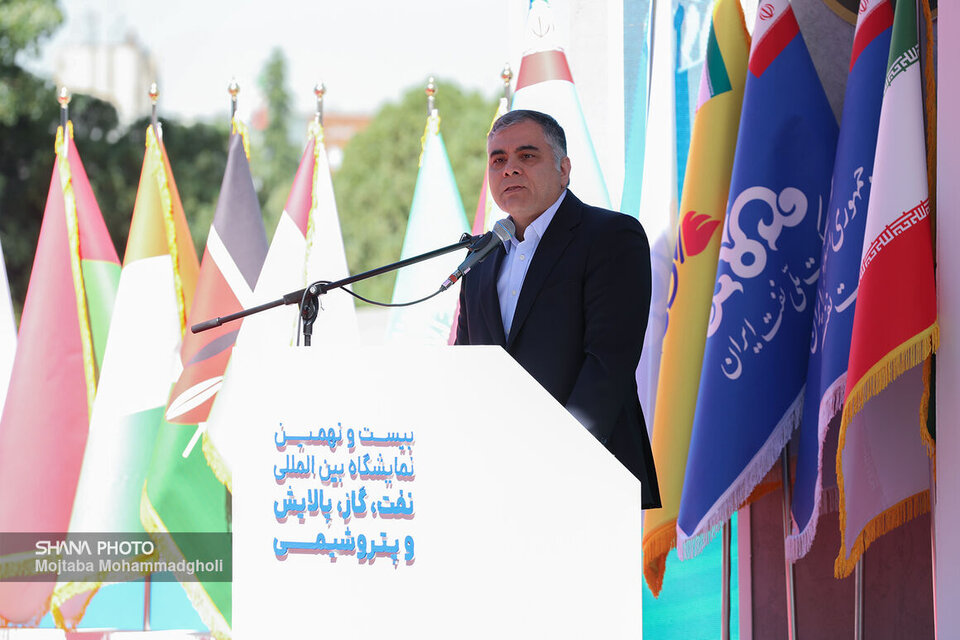Mohsen Paknejad stated that oil exports continue at their highest possible level despite intensified sanctions, adding, "This is only the beginning of our path."
Paknejad spoke Thursday at the opening ceremony of the 29th International Oil, Gas, Refining & Petrochemical Exhibition (Iran Oil Show 2025), thanking leaders of the three branches of government, cabinet members, lawmakers, ambassadors, and international guests. He said, "Today, we have a historic opportunity at this global gathering to showcase Iran’s oil industry capabilities. This exhibition is not just a trade event but a symbol of Iran’s national resolve to become an energy hub and a center for regional cooperation."
Referring to this year’s exhibition theme, "Oil Industry Investment: A Guarantee for Economic Growth and Development," Paknejad said it aligns with the Leader’s directives for the new year. He added, "This slogan reflects the Oil Ministry’s priorities and approach for the current year."
Bridging experience, innovation in oil industry with startups and major firms
The minister highlighted the exhibition’s broad scope, covering over 37 specialized areas from upstream to downstream oil and gas, as well as investment, financing, trade, and new technologies.
He noted that the presence of startups, innovative firms, leading universities, and tech parks alongside major industrial companies demonstrates the integration of experience and innovation in advancing the oil sector.
Paknejad said the main goal of this year’s exhibition is to strengthen investment through specific operational projects, stating, "We believe the oil industry must be redefined based on modern knowledge and advanced technology. In this path, supporting domestic production and empowering Iranian experts is a top priority."
He outlined the Oil Ministry’s efforts over the past nine months, emphasizing serious operational steps toward the 7th Development Plan’s goals. Several key contracts for oil and gas field development and maintenance have been finalized, and multiple projects—including flare gas recovery and refinery quality improvement—have been completed or are ready for operation.
Plans to complete 30 major oil projects with $10b investment
Paknejad reported that oil production capacity has increased by 150,000 barrels per day under the current administration, while crude gas production rose by 30 million cubic meters per day. Refining capacity grew by 180,000 barrels per day, and petrochemical production capacity increased by 7 million metric tons annually. Gasoline and diesel production rose by 7 million and 8 million liters per day, respectively, while oil exports continue at peak levels despite sanctions.
He announced plans to complete over 30 major oil industry projects with nearly $10 billion in investment by March 2026, which would boost daily oil production by 250,000 barrels and crude gas output by 30 million cubic meters per day.
Key priorities: Attracting investment, streamlining contracts
To achieve the Seventh Development Plan’s goals and enhance private sector involvement, the Oil Ministry is prioritizing investment and financing for development projects. "We need over $20 billion annually to develop and maintain oil and gas fields," Paknejad said. "Attracting this level of investment requires redesigning tools, introducing innovative solutions, and leveraging new capacities."
He praised a recent Cabinet approval allowing energy-intensive and petrochemical industries to participate in gas field development, calling it a positive step. "Under the Seventh Development Plan, investment pathways must be smoothed to reduce gas imbalances, and the first contract in this field will be signed at this exhibition," he added.
Reducing contract finalization time, enhancing investment appeal
Paknejad stressed that streamlining contract processes is a top priority, noting that delays of three to four years were unjustifiable and deterred investment. Thanks to recent efforts and an Economic Council resolution, contract finalization for upstream oil and gas projects has been reduced from three years to under one year.
New incentives, including higher internal rates of return, tax benefits, and bonuses for excess production, have been introduced to make oil and gas contracts more attractive. The Oil Ministry has also developed new contractual frameworks to reduce risk, increase transparency, and accelerate returns, including revised IPC models, public-private partnerships, and a $6 billion oil guarantee fund.
Supporting domestic production, showcasing investment opportunities
The minister highlighted the signing of 86 contracts worth $200 million with 68 NTBFs, leading to cost savings and self-sufficiency in refinery equipment. At this year’s exhibition, 16 first-time production projects worth $150 million will be signed with such firms.
Over 200 upstream investment opportunities were recently presented at an oil and gas development event, reflecting the ministry’s commitment to private sector involvement. Paknejad also mentioned efforts to utilize domestic resources, including the National Development Fund and banks, while attracting international financing, with hopes of signing over $10 billion in contracts this year.
Expanding Iran’s role in global energy trade
The minister emphasized international cooperation, particularly with neighboring countries, to open new markets and increase Iran’s share in global energy trade. A recent gas swap deal with Turkmenistan and Turkey strengthens Iran’s position as a regional energy hub.
Paknejad also noted Iran’s collaboration with Russia, including discussions at the 18th Iran-Russia Joint Economic Commission meeting, aimed at creating a secure legal framework for joint investments.
Embracing new technologies, AI
In closing, Paknejad stressed the importance of emerging technologies like artificial intelligence in the oil and gas value chain. He also thanked the president and Leader for their support, calling oil a "divine blessing" that should drive national progress.
The 29th International Oil, Gas, Refining & Petrochemical Exhibition (Iran Oil Show 2025) runs for four days at Tehran Permanent International Fairgrounds, open to visitors from 8 a.m. to 3 p.m.


Your Comment